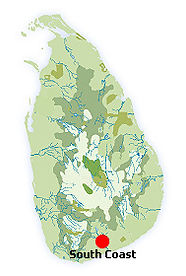HAMBANTOTA
The narrative of Hambantota, now emerging as a maritime hub of the Indian Ocean has to start with its name. It marks the transition from the wet zone to the dry zone that opens in to the plains of shrub jungle. The topography of the south of the island is in throes of a great transformation with an International airport.
To the curious it may be of note that the two largest sanctuaries that are rich in avifauna, Bundala and Kumana are in close proximity to Hambanthota.Migratory birds from Central Asia, Siberia and the Himalayas nest in them. The wide bodied birds of Boeing and Air Bus will want the same tails winds that the Siberian and Himalayan birds rely on when on their Sri Lanka flights.Tissamaharama which derives its name from the impressively large Stupa built in 3rd Century BC is about forty minutes from Hambanthota. The historic town is the base for you to visit the Yala National park by 4X4 safaris. The manmade lake with its huge flocks of egrets, along with gentle breezes may convince you to take a boat trip around the lake.
A half hour away is the famous Kataragama shrine dedicated to god Skanda, son of Shiva and god of war and wisdom. The origins of the present shrine is obscured in the mist of history so ancient that legend takes over. The shrine is sacred to both Buddhist and Hindus.What is fascinating is that there is an old pilgrim route that connects Jaffna in the north of Sri Lanka with the shrine that is only a few miles from Kirinde, a Sri Lanka beach resort that is at the extreme end of the south coast.

Hambantota Information and Google Map
PROVINCE : SOUTHERN PROVINCE
DISTRICT : HAMBANTOTA DISTRICT
POPULAR : BEACH,RELAX,
WEATHER : 31 °C
PHOTO GALLERY
Historical Background
Hambantota port city of today was also the refuge of Malay seafarers who attempted to sail with the westerly winds from the straits of Malacca. The Malay voyagers came in their Sampans on the ancient maritime silk route. The town still has the largest Malay community whose forefathers brought their women along in their pursuit of a permanent piece of vacation Sri Lanka.The tides of trade in a new world order have again transformed the fortunes of this newest deep water port city that caters to the constant flow of maritime traffic in both directions between the straits of Malacca and the Arabian sea.
Shopping
An hour south of Hambantota, bustling Tangalle is the center of commerce in this part of the island. Every Wednesday and Saturday, vendors flock to its covered market to sell their wares—everything from pots of buffalo curd to fruits and vegetables to handwoven baskets and ayurvedic potions. The town’s main drag is also home to a procession of clothes and souvenir shops where you can spend some of your rupees.
Eating
The fields surrounding Hambantota are lush and fertile, producing all manner of exotic fruits and vegetables. Pull up at one of the many roadside farm stands in and around the city and, depending on the season, pick up local produce like pineapples, mangoes, sugarcane, watermelons, bananas, long beans, calabashes, pumpkins and okra.
Climate
Traditionally, the best time to visit the South coast is from mid-November to April, with similar weather patterns to the west coast. Between May and September, travel east beyond Galle along the south coast and more settled weather can often result. October can see heavy rain, although by November good weather is expected till May. Sri Lanka is affected by two monsoons which generally means that there is good weather somewhere. The main south-west (“yala”) monsoon brings rain to the west and south-west coasts and hills largely between May and July. The north-east (“maha”) monsoon hits the east coast predominantly from November to January. There is also an inter-monsoonal period of unsettled weather in October.
Sights
No beach is more magnificent than Mirissa, which is popular for surfing, snorkelling, scuba diving, deep-sea fishing, sailing and sea-kayaking. During the migration season in December and April, large pods of Dolphins and Blue Whales can be seen just a few miles offshore from Mirissa. Mirissa Water Sports, based in the Mirissa Harbour offers boat excursions which can take up to three hours.
At Ahangama, Midigama and Weligama, surfers prowl the shores in search of some of the best waves in Sri Lanka. Dondra Head, with its octagonal lighthouse, marks Sri Lanka's most southerly tip. Close-by, lie the beaches of Polhena and especially Talalla, a gorgeous beach that remains relatively unknown. Dickwella is known for its beaches and scuba diving. Dickwella’s Beeralu Lace Craft Village shows off hand woven Beeralu lace (pillow lace) which is a recognised national craft and a vital source of income for rural women of the south coast. Tangalle offers a glorious, uninterrupted stretch of beach. Seek-out the small and often deserted cove of Seenimodera (Sugar Bay).
The southern coast also serves as an ideal base to explore the south’s wildlife parks including Yala and Uda Walawe National Parks and Bundala.








